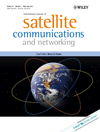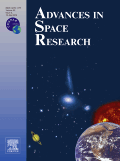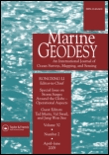
GPS SOLUTIONS
Scope & Guideline
Charting New Territories in Earth Sciences
Introduction
Aims and Scopes
- GNSS Positioning Techniques:
The journal extensively covers advancements in GNSS positioning methods, including precise point positioning (PPP), real-time kinematic (RTK) techniques, and multi-GNSS integration to enhance accuracy and reliability. - Signal Processing and Error Mitigation:
Research on signal processing techniques to mitigate errors from multipath effects, noise, and interference is a core focus, utilizing methods such as machine learning, Kalman filtering, and statistical modeling. - Atmospheric and Environmental Applications:
GPS Solutions emphasizes the application of GNSS technology in atmospheric studies, including tropospheric delay modeling, ionospheric monitoring, and meteorological applications, showcasing the interdisciplinary nature of GNSS research. - Satellite Systems and Innovations:
The journal explores innovations in satellite technology, including the analysis of new GNSS signals, satellite clock estimation, and the integration of satellite-based augmentation systems (SBAS) and inter-satellite links. - Low-Cost GNSS Solutions:
A growing area of research involves the development and evaluation of low-cost GNSS systems, addressing challenges in urban environments and enhancing accessibility for various applications.
Trending and Emerging
- Machine Learning and AI Integration:
The integration of machine learning and artificial intelligence in GNSS applications is rapidly gaining traction, with studies focusing on improving positioning accuracy, signal processing, and error detection. - Real-Time and Cloud-Based Solutions:
There is an increasing trend towards real-time GNSS solutions and cloud-based processing methods that enhance data accessibility and processing efficiency for users in various fields. - Advanced Multipath Mitigation Techniques:
Research on innovative multipath mitigation strategies has surged, utilizing advanced modeling techniques and machine learning to improve positioning in challenging environments. - Ionospheric and Tropospheric Studies:
A growing emphasis on atmospheric studies, particularly ionospheric and tropospheric modeling, reflects the importance of understanding environmental impacts on GNSS signals for improved accuracy. - Low-Cost and Accessible GNSS Technologies:
Emerging research on low-cost GNSS technologies and their applications in urban settings demonstrates a commitment to making GNSS solutions more accessible and practical for everyday use.
Declining or Waning
- Traditional Geodetic Techniques:
There has been a decline in publications centered on traditional geodetic techniques, as newer methodologies utilizing advanced GNSS applications and machine learning approaches gain prominence. - Single-Constellation Studies:
Research focused solely on individual GNSS constellations, such as GPS or GLONASS, has waned, as the emphasis has shifted towards multi-constellation systems that enhance positioning accuracy and reliability. - Static Positioning Applications:
Static GNSS applications, particularly those that do not leverage real-time processing or advanced algorithms, are becoming less common as the field moves towards dynamic and real-time applications. - Basic Signal Processing Techniques:
There is a noticeable reduction in studies that focus on basic signal processing techniques, as more sophisticated and integrated approaches, including machine learning and adaptive algorithms, take precedence.
Similar Journals

INTERNATIONAL JOURNAL OF SATELLITE COMMUNICATIONS AND NETWORKING
Shaping the Landscape of Satellite CommunicationsInternational Journal of Satellite Communications and Networking is a premier academic journal published by Wiley, dedicated to advancing knowledge in the fields of satellite communications and networking. With an ISSN of 1542-0973 and E-ISSN 1542-0981, this journal has been a significant contributor to the discourse surrounding electronic and media technologies since its inception in 2003. Recognized for its rigorous peer-review process, it has achieved notable rankings, placing in the Q2 and Q3 quartiles across various categories, highlighting its impact and relevance in the competitive domains of Engineering and Media Technology. Researchers, professionals, and students can benefit from access to cutting-edge research and innovations in satellite communications, as it ranks #18/63 in Engineering Media Technology and #323/797 in Electrical and Electronic Engineering. The journal's commitment to fostering a deeper understanding of networking technology makes it an essential resource for anyone looking to stay at the forefront of this rapidly evolving industry.

Remote Sensing in Ecology and Conservation
Transforming ecological understanding with open-access discoveries.Remote Sensing in Ecology and Conservation is a pioneering journal published by WILEY that has been a beacon of open-access research since 2015. With an E-ISSN of 2056-3485, this journal stands at the forefront of the intersection between ecological research and technological innovation. It is recognized for its significant impact, boasting Q1 rankings across several prestigious categories in 2023, including Computers in Earth Sciences and Ecology, emphasizing its commitment to high-quality, influential scholarship. The journal provides a platform for researchers and practitioners to share their findings in remote sensing applications that advance ecological conservation efforts. Encompassing a broad scope that includes studies on landscape changes, biodiversity assessments, and environmental monitoring, it serves as an essential resource for education and practice in the field. With impressive ranks in Scopus, including a remarkable 6th place in Earth and Planetary Sciences, it continues to shape the dialogue in ecology and conservation. As an open-access journal, it champions the dissemination of knowledge, making critical research accessible to a global audience, thereby fostering innovation and collaboration in the pursuit of sustainable environmental practices.

Reports on Geodesy and Geoinformatics
Exploring new horizons in geodesy and geoinformatics research.Reports on Geodesy and Geoinformatics, an esteemed scholarly journal published by SCIENDO, stands as a vital platform in the field of geodesy, geoinformatics, and related sciences. With an ISSN of 2391-8365 and E-ISSN 2391-8152, this open-access journal has been providing free access to impactful research and advancements in the domain since 2013. Located in Warsaw, Poland, at Bogumila Zuga 32A, Mazovia 01-811, it aims to disseminate high-quality research articles, case studies, and reviews that are crucial for academics, industry professionals, and students alike. The journal's commitment to promoting innovative methodologies and technological advancements reinforces its position as an important resource for fostering collaboration and knowledge sharing across global communities in geodesy and geoinformatics.

Chinese Space Science and Technology
Pioneering Research for Tomorrow's Space TechnologyChinese Space Science and Technology is a pivotal journal dedicated to advancing the field of space engineering and technology, published by the esteemed Chinese Academy of Space Technology. With an ISSN of 1000-758X, this publication serves as a significant platform for cutting-edge research from China and around the globe, spanning vital intersections of Aerospace Engineering, Electrical and Electronic Engineering, and Materials Science. As evidenced by its Q3 ranking in 2023 across these categories, the journal consistently showcases innovative studies that contribute to the development of space technology, thereby impacting both theoretical frameworks and practical applications in the industry. Researchers and professionals will find valuable insights within its pages, while students can enrich their educational journey through its wealth of knowledge. Though primarily published in print, the journal continues to foster collaboration and engagement among the academic community, offering a glimpse into the future of space exploration and technological advancements through its relevant and timely content.

Revista de Teledeteccion
Exploring the frontiers of satellite technology.Revista de Teledeteccion, published by UNIV POLITECNICA VALENCIA, EDITORIAL UPV, is a leading Open Access journal dedicated to the interdisciplinary field of remote sensing and its applications. Since its inception in 2010, this journal has provided a vital platform for researchers, professionals, and students to disseminate groundbreaking findings, foster collaboration, and engage with contemporary challenges in Earth and Planetary Sciences as well as Geography, Planning, and Development. With a Q3 ranking in both fields as of 2023, it serves as an essential resource for advancing knowledge and innovative practices in hi-tech remote sensing methodologies. The journal covers a broad spectrum of topics, from satellite imaging techniques to environmental monitoring, making it an invaluable asset for those interested in harnessing remote sensing technologies to address real-world issues. The editorial office is located in Valencia, Spain, and the journal aims to bridge the gap between theoretical research and practical application, enriching the scientific community's understanding and capabilities in this dynamic domain.

Signal Image and Video Processing
Innovating Imaging and Video TechnologiesSignal Image and Video Processing, published by Springer London Ltd, is a cutting-edge academic journal dedicated to the fields of electrical and electronic engineering and signal processing. With an ISSN of 1863-1703 and an E-ISSN of 1863-1711, this journal plays a pivotal role in disseminating innovative research findings from 2007 to 2024, boasting a commendable Q2 ranking in its respective categories. Located in the United Kingdom, the journal attracts a diverse readership of researchers, professionals, and students eager to explore advancements in signal processing technologies and their applications in imaging and video analysis. Although it does not offer open access, its rigorous peer-review process ensures the publication of high-quality, impactful research, evident by its respectable rankings within Scopus in both electrical engineering and computer science domains. The journal serves as vital resource for those aiming to stay at the forefront of technological developments and research in image and video processing.

JOURNAL OF GEODESY
Advancing Geodesy: Shaping Our Understanding of EarthJOURNAL OF GEODESY, published by SPRINGER, is a premier academic journal dedicated to advancing the field of geodesy and its related disciplines. With an impact factor reflecting its high citation rate and rigorous peer-review process, this journal occupies a distinguished place in the academic community, categorized within the Q1 quartiles for Computers in Earth Sciences, Geochemistry and Petrology, and Geophysics as of 2023. The journal addresses various critical topics affecting our understanding of Earth’s shape, gravity field, and rotational dynamics, thus providing vital insights for researchers, professionals, and students alike. Derived from a legacy that spans from 1995 to 2024, the journal continues to publish significant contributions that foster growth in Earth and planetary sciences, with rankings that place it within the top tier of its categories: 10th in Geophysics, 13th in Geochemistry and Petrology, and 9th in Computers in Earth Sciences, all reflecting percentile rankings above 88%. Although Open Access options are not currently available, the journal remains an essential resource for advancing geodetic research across the globe. Explore the latest findings and connect with leading experts in the field through this highly regarded platform.

MULTIMEDIA TOOLS AND APPLICATIONS
Pioneering insights in multimedia tools and their applications.MULTIMEDIA TOOLS AND APPLICATIONS, published by Springer, is a highly regarded journal in the fields of Computer Networks and Communications, Hardware and Architecture, Media Technology, and Software. Since its inception in 1995, this journal has established itself as a vital platform for disseminating innovative research and developments, maintaining a prominent position evidenced by its Q2 and Q1 rankings across various categories as of 2023. With an ISSN of 1380-7501 and an E-ISSN of 1573-7721, it continues to attract high-quality contributions from scholars and practitioners worldwide. Although it does not currently offer Open Access options, its impact is reflected in impressive Scopus rankings, placing it in the top quartiles in multiple categories, including a remarkable 10th rank in Media Technology. As the field evolves rapidly, the journal’s objectives encompass advancing multimedia technologies and exploring their multifaceted applications, making it an essential resource for researchers, professionals, and students seeking to stay at the forefront of this dynamic discipline. For more information, visit the journal's page to explore recent publications and submission guidelines.

ADVANCES IN SPACE RESEARCH
Unveiling the Mysteries of Space and Beyond.ADVANCES IN SPACE RESEARCH, published by Elsevier Science Ltd, is a leading journal in the fields of Aerospace Engineering, Astronomy and Astrophysics, Atmospheric Science, and more. Since its inception in 1981, this journal has dedicated itself to the dissemination of high-quality research contributing to the understanding of space and planetary sciences through a multidisciplinary lens. With an impressive impact factor reflected in its positioning within the Q1 and Q2 quartiles across various categories, it serves as an essential resource for researchers and professionals alike. The journal's rigorous peer review process ensures that only the most relevant and groundbreaking studies are published, making it a cornerstone for those navigating the complexities of space research. The journal is accessible by subscription, inviting a global readership to engage with trailblazing research that influences future advancements and fosters collaborations across the scientific community. With a reputation for excellence, ADVANCES IN SPACE RESEARCH remains committed to pushing the boundaries of knowledge in the ever-evolving field of space exploration.

MARINE GEODESY
Navigating the Intersection of Oceanography and Geospatial ScienceMARINE GEODESY, an esteemed journal published by Taylor & Francis Inc, delves into the intricate field of oceanography, aiming to contribute profoundly to the understanding of marine spatial dynamics and geophysical processes. With an ISSN of 0149-0419 and an E-ISSN of 1521-060X, this journal has a commendable standing, currently classified in the 2023 Q2 quartile, reflecting its influential presence in the realm of Earth and Planetary Sciences, particularly oceanography, where it ranks 49th out of 145 journals. Since its inception in 1977 and its ongoing publication until 2024, MARINE GEODESY has been dedicated to disseminating groundbreaking research, case studies, and reviews that are crucial for scholars, professionals, and students engaged in the exploration of marine environments. While currently not an open-access journal, it nevertheless offers vital insights into marine geospatial analytics and geodesy, augmenting the knowledge base necessary for tackling contemporary challenges in marine science and geography.